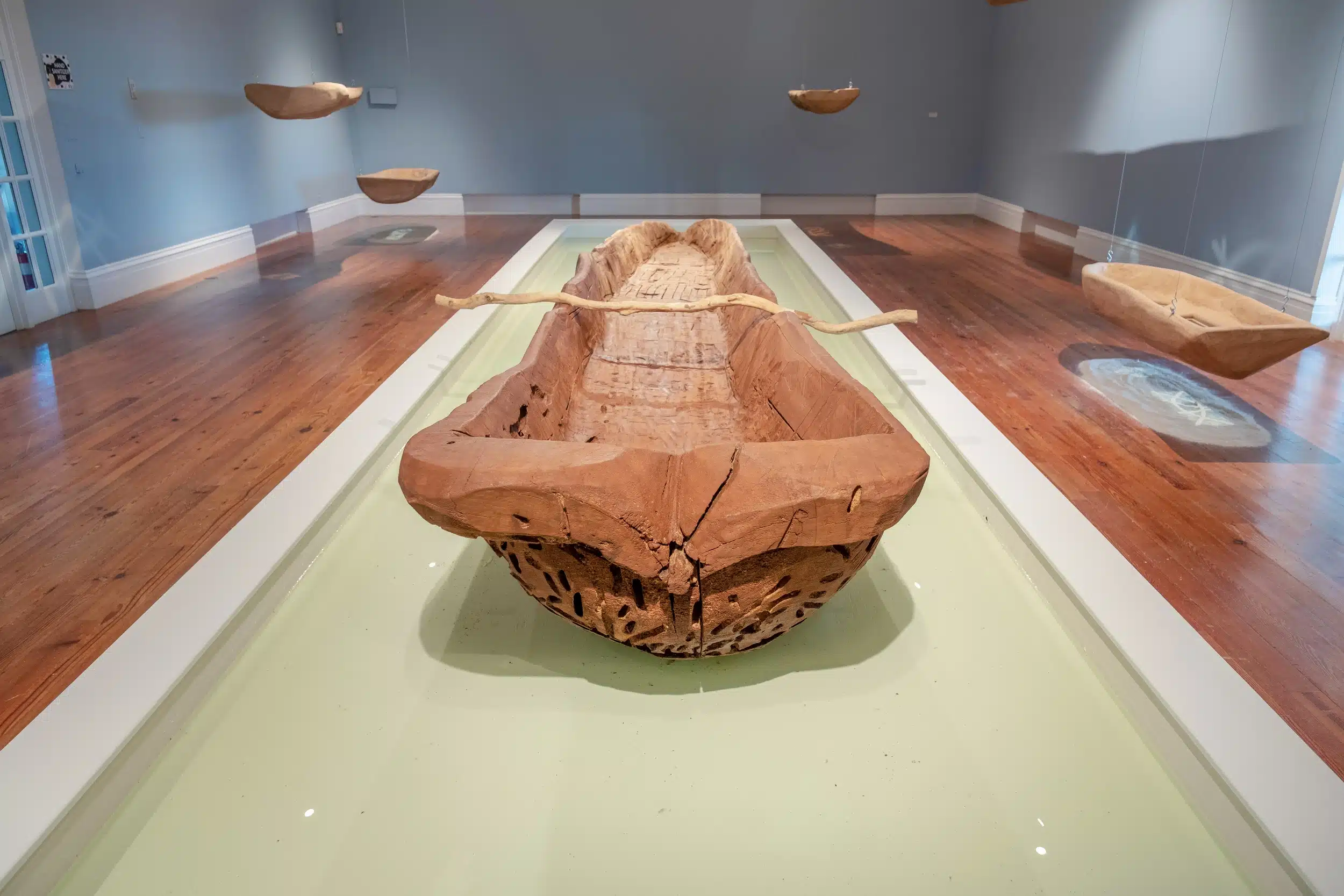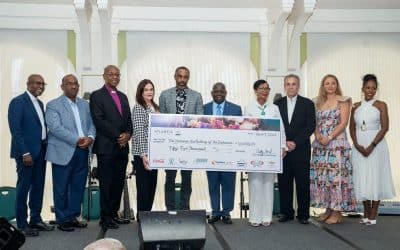
By Letitia Pratt, Associate Curator

Installation view of Mabrika (2022) by Antonius Roberts. Wood (silk cotton), fused glass. Dimensions variable. Photo: Jackson Petit.
As you enter the ballroom of Antonius Robert’s most recent exhibition, Art, Ecology, and Sacred Space, curated by Dr. Krista Thompson, you are arrested with the strangeness of the installation that engulfs the entire room. Aptly named Mabrika, or, “Welcome” the installation is an assortment of boats carved out from silk cotton wood made to resemble the canoes that Lucayans used to travel between islands. All the vessels are suspended mid-air with stained glass windows nestled in their bottoms, save for one: the fleet surrounds a singular, large boat stationed in the middle of the room gently floating in a box filled with water. The entire scene reads like an arrival; it is as if any visitors to the installation is walking in the sea between these boats; or, as if the boats are floating through space, waiting to port among us, on earth. This installation is a great example of the imagination employed when artists engage with histories of the past, particularly when the histories they engage with have been erased or ignored through colonization. Antonius Roberts’ engagement with indigenous history imagines a reality where colonization has not disrupted indigenous progress and connects their erasure to African histories that have been suppressed or ignored through time.
When we think about Afrofuturism, we often think about space-cadets, technology-bending epics, or body mythologizing fantasies that dig into African history. Coined by Mark Dery in his 1993 essay “Black to the Future”, Afrofuturism is a philosophy that frames discussions about afro-centric art and social histories through the lens of science and technology.1 When we take a more considered look at Caribbean futurism, there is typically also a concern with conflating histories of the landscape as indistinguishable from one another, connecting on a continuum colonial realities that is in constant need to be solved, subverted, or imagined to be non-existent. The multiplicity inherent to Caribbean futurism reflects the Pluralism that is at the core of Caribbeanness; poet and scholar Kamau Brathwaite’s Caribbean Man in Space and Time defines this pluralism as a culture that emerges from the collaged conditions of our lived reality.2 Thus, when we analyze Roberts’ career-spanning history with engaging with the landscape, this collage becomes more apparent as we see his negotiation between the colonial realities begin to stack upon each other through one conceptual frame. Roberts will often investigate African sacred ecological practices with contemporary questioning: in Mabrika, he asks, “how can we honor the land as our ancestors did?” and “How can we contend with climate change and our new ecological reality?” With these questions he then acknowledges that Afro-Bahamians have been transported into this space (a post-apocalyptic reality in and of itself) and thus begins new investigations on the people that were once in deep communion with this landscape pre-colonization.

Stained-glass detail in Mabrika (2022) by Antonius Roberts. Wood (silk cotton), fused glass. Photo: Jackson Petit.
These questions are not uncommon for the typical Caribbean futurist. Another key feature of the genre is using past histories and mythologies to (re)imagine the future. Roberts’ futurism is especially apparent in his ecological aesthetics; installations like Mabrika blends both the Lucayan and Afro-Indigenous aesthetics through his use of Silk Cotton wood to fashion the canoes. Krista Thompson acknowledges that this tree is important to Afro- Bahamians and Afro-indigenous practices (102), stating that it “may have also reminded the Island’s Black inhabitants of other places, namely African homelands, or sacred grounds. They made the tree the focus of their religious or spiritual practice (…).”3 Thus the Silk Cotton is already a space where time and history collapses as local Afro-Bahamians engage in remembering while contending with their contemporary reality. To use this as a medium to memorialise Lucayan ingenuity, then, idealises the imaginations of the two groups as the basis for colonial escape and progress. Even the vessel—the canoe—suggests travel, escape, leaving; this is further solidified by the build of the installation, where the boats float in air, as if we have caught them riding away, mid-flight.

Installation view of Mabrika (2022) by Antonius Roberts. Wood (silk cotton), fused glass. 24′ x 3′. Photo: Jackson Petit.
Roberts’ aesthetic connection between afro—and indigenous—futures is not new. We see this conflation happening in science fiction across the region. Nalo Hopkinson, a Jamaican writer with both Afro- and Taino- descent, also combines lore in her novel Midnight Robber and grounds it by imagining a tree as the centre of this stacking. Similar to Roberts’ canoes, the setting of the “New Half-Way Tree” becomes a space where histories and time collapses into one decolonial narrative. Indigenous activist and scholar Grace L. Dillon acknowledges the correlation between afro—and indigenous—futures in her anthology of collected indigenous writings called Walking the Clouds, ultimately stating that each of the philosophies feed and inspire each other.4 She writes on Midnight Robber: “Called New Halfway Tree, the setting replicates features not only of the Caribbean (Hopkinson’s home in her youth) but also of northern Aboriginal Canada (near her current residence in Toronto) and the Australian Aborigine bush. Mirroring this multitude of geographical sources…plac[es] the reader in worlds that split apart the colonizer vs. colonized binary that occurs in much of sf” [sic]. (100) Like Roberts, the story reflects the pluralism of the Caribbean reality as Hopkinson breaks down illusions of separation under one artistic frame.
Science fiction, in general, often plays with the idea of time – timelines are broken, conflated, looped – and the multiplicity within Caribbean futurist works does just this. With Mabrika, time seems frozen, as if to argue that modern Bahamians are also currently contending with the issues that the Lucayans did. We are frozen in this timeline. What that means for our future in this ecological reality is brought into focus: How will we survive climate change? And how do we survive under capitalism and our colonial reality?
An integral part of decolonization using our imagination to contend with these questions: we imagine a world where we can move beyond violence, or a world where this violence has not threatened African/Indigenous sovereignty or progress. With this imagination we can return to ourselves and transcend the past, present, and future.
Works Cited
- Dery, Mark. (1993) “Black to the Future.” Flame Wars: The Discourse of Cyberculture. Durham: Duke University Press.
- Brathwaite, K. (1975) “Caribbean Man in Space and Time”. Originally published in Savacou 11 and 12. Reprinted in the Digital Caribbean: CUNY Academic Commons. Accessed June 15th. https://digitalcaribbean.commons.gc.cuny.edu/files/2014/02/Caribbean-man.pdf
- Thompson, K. (2006) An Eye for The Tropics: Tourism, Photography, and Framing the Caribbean Picturesque. Durham: Duke University Press.
- Dillion, Grace L. (2012) Walking the Clouds: An Anthology of Indigenous Science Fiction. Arizona: University of Arizona Press.

